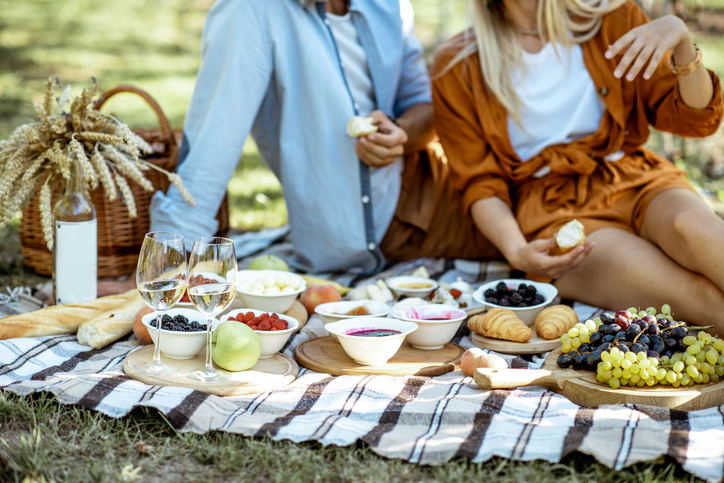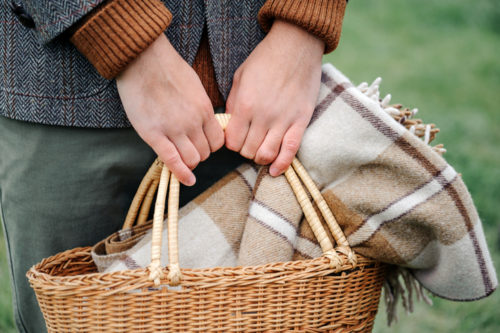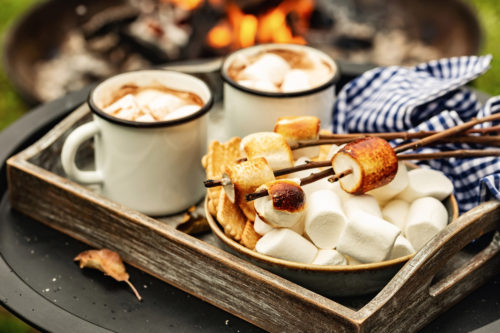
24 Sep How to Host a Safe and Welcoming Dinner Party During a Pandemic

By Jen Verola and Toby Amidor
As the hot summer evenings fade into cool fall nights, the idea of hosting a cozy outdoor dinner party may seem appealing. It’s an opportunity to connect with friends and family over your favorite fall comfort foods, roast marshmallows by the fire pit under a warm blanket, and enjoy the crisp fall air before winter forces us inside. But can you safely host a dinner party during a pandemic? The answer can be yes. Follow these simple recommendations for a seamless and safe evening.

Eat outside and maintain six feet.
The Centers for Disease Control (CDC) suggests outdoor spaces are less risky than indoor spaces, as it is easier to keep people six feet apart and there is more ventilation outdoors.1 Host the entire event outside and consider the number of people that can safely fit in your outdoor space while maintaining six feet between individual households. If the weather is getting slightly cooler at night, think about investing in outdoor heat lamps and asking guests to bring throw blankets or dress warmly.
Set up one seating area for each household.
Provide each household with their own individual table or picnic blanket, and place each seating area at least six feet apart from one another. This way, guests can safely enjoy their meals while maintaining social distancing. As the gathering size increases, the potential risk for transmission increases as well; keep the guest list small, inviting only one other household or less than 10 people (or check with your local area for limits recommended) so all of your guests feel comfortable attending.2

Decrease the number of people handling and serving food.
There are several ways you can do this. One is to provide each household with an individual buffet area so guests can safely serve themselves. To do this, portion each dish into one bowl per household. Your guests will be the only people handling their food throughout the evening. Designate one person (or yourself) to serve any shareable item, such as condiments or dressings, or provide one of each for every household.
Alternatively, ask your guests to stay outside of the kitchen or any area where food is being prepared. Ideally, your family should be the only people handling food.3
Be aware that while COVID-19 is not spread through food, it is important to wash your hands frequently while preparing food and while touching serving bowls or utensils that guests may come in contact with later.4
Use disposables and set up one garbage for each household.
Use all disposable utensils, plates, napkins, and cups, and give each household their own garbage bag. Guests can clean up after themselves, reducing the need for anyone to come inside. Have Sharpie markers handy to provide to each family so everyone can write their names on their disposable cups.
Communicate ground rules before guests arrive.
Remind your guests to maintain social distancing, and to wear masks when not eating or when not able to maintain an appropriate distance. Let them know if they will be able to use the bathroom, and if so, which one will be designated for guest use.
Remember that no social interaction is without risk, but you can safely minimize your risk with each of these recommendations. Continue to follow the CDC recommendations to protect yourself and others, and enjoy your socially distanced evening!5
References
- Centers for Disease Control and Prevention. Deciding to Go Out. Centers for Disease Control and Prevention. https://www.cdc.gov/coronavirus/2019-ncov/daily-life-coping/deciding-to-go-out.html. Published June 15, 2020. Accessed June 15, 2020.
- Centers for Disease Control and Prevention. Considerations for Events and Gatherings. Centers for Disease Control and Prevention. https://www.cdc.gov/coronavirus/2019-ncov/community/large-events/considerations-for-events-gatherings.html. Published June 12, 2020. Accessed June 15, 2020.
- Centers for Disease Control and Prevention. Personal and Social Activities. Centers for Disease Control and Prevention. https://www.cdc.gov/coronavirus/2019-ncov/daily-life-coping/personal-social-activities.html. Published June 15, 2020. Accessed June 17, 2020.
- Centers for Disease Control and Prevention. Food Safety and Coronavirus Disease 2019 (COVID-19) https://www.cdc.gov/foodsafety/newsletter/food-safety-and-Coronavirus.html. Published May 11, 2020. Accessed June 17, 2020.
- Centers for Disease Control and Prevention. How to Protect Yourself & Others. Centers for Disease Control and Prevention. https://www.cdc.gov/coronavirus/2019-ncov/prevent-getting-sick/prevention.html. Published April 24, 2020. Accessed June 15, 2020.
Jen Verola is a registered dietitian and certified lactation counselor, and completed her master’s degree in Nutrition and Public Health at Teachers College, Columbia University. As a recent graduate, she hopes to focus her nutrition practice on maternal health, supporting women during the prenatal and postpartum periods. Jen lives in New York City and spends her time cooking with friends and family, practicing yoga, and hiking in upstate NY.

